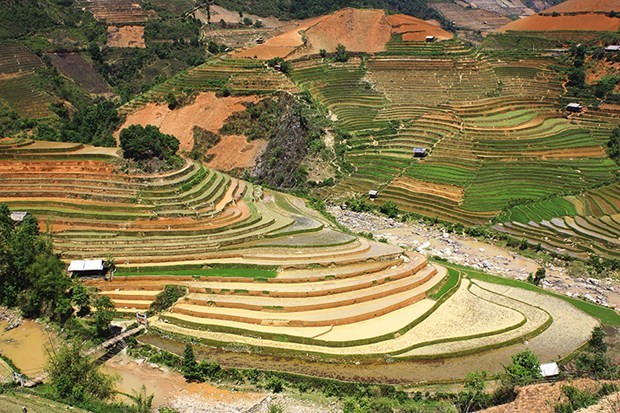Hanoi (VNA) – An array of festive activities will be held from August 29 to October 18 in Mu Cang Chai district, the northern province of Yen Bai, to celebrate the National Day (September 2) as well as promote the beauty of the local terraced rice fields.
According to Luong Thi Xuyen, Vice Chairwoman of the local People’ Committee, the district has carried out a plan to organise the event under the theme of “Mu Cang Chai – identity, safety, hospitality”.
“The activities aim to popularise, honour and promote the strengths and potential of cultural development, sports and the cultural heritage of ethnic groups in the district; in addition to raising awareness of preserving and promoting the values of historical relics associated with tourism which will contribute to provincial socio-economic development.
“Mu Cang Chai festival is also expected to create a link of sustainable tourism development between localities in Yen Bai Province and the northwestern region, forming the district’s own quality tourism products which are new, unique, attractive and friendly,” Xuyen said.
The activities include the opening ceremony on September 26 during which the Certificate for Special National Heritage will be granted in honour of the district's terraced rice fields.
There are also musical shows on Saturday nights, a fair of local farm products, traditional games, a photo exhibition featuring the district's majestic natural beauty, and many other cultural activities
The new highlights of this year’s festival are the Discover Mu Cang Chai marathon with the participation of 100 athletes, a helicopter cruise to experience the landscape from above, a camping festival and the district's four-season outdoor spectacle.
Visitors to the festival will have opportunities to discover traditional sports and folk games such as nem con (throwing a sacred ball through a ring) of Thai people, tug of war, day gay (stick pushing), and di ca kheo (stilt walking).
According to the organising board, all measures to prevent the COVID-19 pandemic will be tightened during the festival. All participants will be required to wear masks, wash hands with disinfectants and follow social distancing.
Mu Cang Chai, a remote district which is home to breathtaking terraced rice fields in Vietnam’s northern province of Yen Bai, should top the travel list, according to US-based media site CNBC.
CNBC describes Mu Cang Chai as a remote gem deep in the valleys formed by water of the Red River with a series of colourful mountainous villages encircled by fields of towering rice terraces.
“The fields are agricultural feats of precision — rugged mountains blanketed with emerald stairways that, seemingly, ascend to the heavens above,” it says.
The site goes on to describe how rice terraces have been grown in Mu Cang Chai, saying the ancestors of northern Vietnam’s local hill tribes centuries ago created this beautiful place for the most basic of reasons — to survive.
“To grow rice in vertical conditions, hill tribes created a terraced system to control the downward flow of water. Using ingenuity, resourcefulness and sheer grunt work, fertile fields of sustenance and breathtaking beauty were born — and still flourish today.”
In Mu Cang Chai, trekking is popular, as is cycling and photography while local festivals attract record numbers of tourists every year, including an autumn paragliding festival that’s helping to establish Mu Cang Chai as a new destination for adventure travel.
Mu Cang Chai district is home to 500 hectares of rice terraces in La Pan Tan, Che Cu Nha and Da Xu Phinh communes, cultivated by the Mong people for centuries. The local terraces are among the 2,500 hectares recognised as national heritage sites in 2007 by the Ministry of Culture, Sports and Tourism and a special national site by Prime Minister Nguyen Xuan Phuc on January 5.
The locality is about 1,000 metres above sea level, making it impossible to cultivate wet rice the same way as in deltas. Local residents grow rice in terraced fields to stop water flowing downhill.
Terraced fields in Mu Cang Chai are beautiful year-round. Visitors in March can see glittering ponds before locals transplant rice seedlings from April to May. After May, the hills are covered in green until the fields start to turn yellow with ripe rice in early September.
During the harvest in October, the golden rice fields stand out amidst green forests./.





























